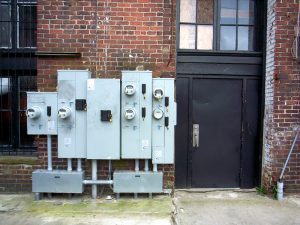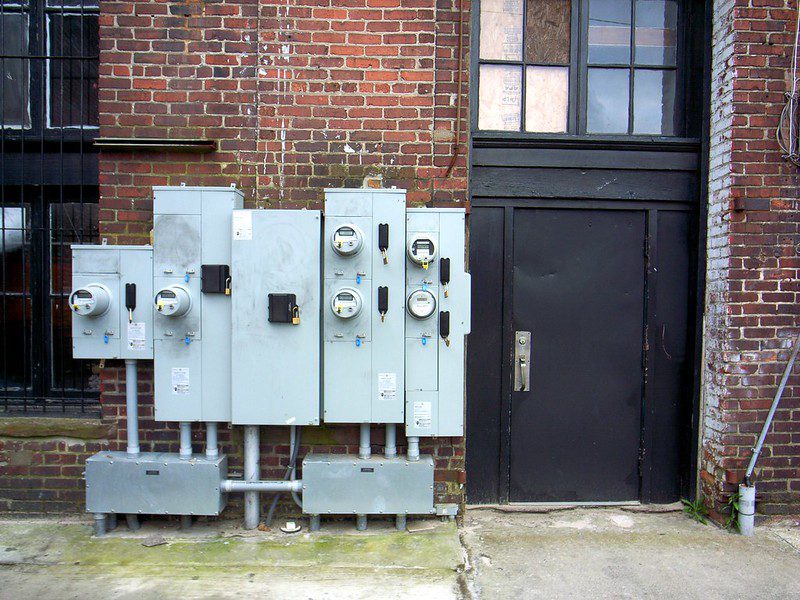
Photo by Flickr user Nicolas Nova, CC-BY-NC-2.0
In the past, members of the community development movement have had little to do with anything that smacks of environmentalism. Conversely, members of the mainstream American environmental movement have shown no particular interest in issues of social justice, economic development and community empowerment. This separation between the two movements has given rise to some very damaging results, the most important of which include:
- The failure to recognize that environmental protection, economic equality, and social justice are interdependent goals, and policies to achieve them should be integrated.
- In the absence of community participation, environmental policies and decisions are made by “technocrats” who have no accountability to communities and who are ignorant of how environmental policies impact communities.
- The emergence of inequities in the distribution of both the costs and benefits of environmental improvement.
- The failure to use the billions being invested each year by both public and private institutions to improve the environment as a new source of capital for community reinvestment.
The emergence of the environmental justice movement from communities of color and poor communities over the past decade has begun to educate both policy-makers and the general public about the connections between environmental and socioeconomic issues. Extensive research has now fully documented that poor people and people of color, in urban and rural areas alike, have borne a disproportionate burden of environmental pollution and environmental degradation and that they have benefited less from environmental movement victories such as wilderness protection, clean air, clean water or reduced exposure to toxics. At the same time, the growing “sustainability” movement has made significant progress in creating new measures of development that incorporate justice and equity as well as environmental quality
Together, the environmental justice movement and the sustainability movement offer many important lessons. Two are particularly important for those whose abiding concern is the reinvestment of this country’s diverse communities. First of all, sustainable communities must be based on economic equality, social justice and environmental protection. Consequently, we must invest in our environment and communities simultaneously. The community development movement should look upon the tremendous amount of resources to improve the environment as a possible new source of capital for community reinvestment. The second lesson, which should already be familiar to most of us, is that accountability is only given when demanded. In other words, unless poor people and people of color demand the right to participate as equal partners at every level of decision-making, they will continue to suffer inequities in the distribution of both the costs and benefits of environmental improvement. More importantly, resources that could have been used for community reinvestment would be just a missed opportunity.
Energy And Low-Income Housing
The U.S. Department of Housing and Urban Development (HUD) defines housing to be affordable if its total cost (i.e., rent plus utilities) does not exceed 30 percent of the tenant’s income. Though much effort has gone into reducing rent (through low-cost financing and subsidies), most developers have neglected the potential of energy conservation to reduce utility costs. This is unfortunate because many studies have shown that energy conservation/efficiency can make housing more affordable by cutting operating and maintenance costs; lowering monthly rent payments; and increasing tenants’ disposable income by reducing their utility bills.
To incorporate energy efficiency into their work, however, low-income housing developers need both money and expertise. Fortunately, owing to the country’s increasing interest in using energy conservation as a pollution prevention strategy, substantial new resources have been created. For example, expenditures by public utilities to reduce customers’ demand for energy (formally known as demand-side management programs) have grown from almost nothing to an estimated $2.5 to $3 billion in 1992. This represents a range of 1.2 percent to 1.4 percent of this industry’s $217 billion in annual revenues. These commitments are expected to grow at rates up to 25 percent annually for the foreseeable future. Leading utilities are already committed to such investments in the range of 2 to 6 percent of revenues in particular service territories. If used creatively and effectively, these new resources can enable housing groups to acquire the necessary expertise and to finance their energy efficiency upgrades.
However, at this time, only less than 5 percent of all utility investments in demand-side management target poor communities and communities of color. To ensure that these resources will actually benefit low-income housing developers, community development agencies must actively participate in the planning, implementation and evaluation of these initiatives.
Chicago’s Story
In 1984, the Housing Abandonment Task Force, a citywide coalition of neighborhood organizations, identified rising energy costs as a major cause of housing abandonment in Chicago. As a member of the Task Force, the Center for Neighborhood Technology (a nonprofit research and advocacy group that seeks to integrate the environmental and community development movements) studied 18 multifamily buildings in five neighborhoods, finding that:
- energy was consuming, on average, 52 percent of the non-financing operating costs of the buildings studied;
- rising energy prices exert increasing financial pressure on the buildings studied;
- without attention to reducing energy consumption, and projecting moderate increases in energy prices, most of the buildings would be operating in the red within ten years; and
- significant reductions in the utility bills of these buildings could be achieved through energy efficiency investments that could pay their way in energy savings in five years or less.
Though the Housing Abandonment Task Force’s study has not been updated, recent research in other cities (see accompanying article) shows that rising energy costs is still a major contributor to housing abandonment, homelessness and even fire deaths. In the meantime, Chicago’s low-income housing crisis continues to worsen.
Unfortunately, there has been, as yet, no concerted effort to incorporate energy upgrades in a comprehensive low-income housing development strategy. In fact, with only very few exceptions, low-income housing developers have not paid much, if at all, attention to energy. Specifically, they have not incorporated energy efficiency standards into their property management, rehab and construction activities.
Community-Based Needs-Assessment And Planning
Long-term solutions to the low-income housing crisis, both in Chicago and nationwide, must reduce the cost of energy through energy conservation and efficiency. To help make this happen, the The Center for Neighborhood Technology began conducting one-on-one interviews with low-income housing developers a few months ago. The purpose of these interviews is to determine the level of awareness and/or interest in energy issues of these low-income housing developers; assess their energy-related needs; identify the obstacles they face in improving the energy efficiency of their facilities; evaluate the feasibility of incorporating energy efficiency standards in their current property management and development activities without additional resources; and to gauge the willingness of these developers to work together as a network to meet these energy-related needs.
Twenty interviews have been completed so far. Though this is a relatively small percentage of the total number of low-income housing developers in Chicago, the the results are suggestive of a number of strategies.
1. Most interviewees thought of utility bills as a given, if they thought about them at all. As a result, energy efficiency standards have not been incorporated into the property management and development activities of these low-income housing developers. In addition, few interviewees had a concrete sense of the cost-cutting potential of energy conservation and efficiency.
2. The common sentiment of the interviewees was that energy efficiency is an important, but not immediate, issue. As a result, energy efficiency upgrades will only be undertaken, if at all, if more time and resources are available.
3. One development organization said that it has always incorporated energy efficiency standards in their development activities. The director of this organization was convinced that their housing units are actually more affordable (i.e., have lower rents) than the units of other organizations because of their energy efficiency improvements.
4. Many interviewees were wary, or even suspicious, of “high-tech” solutions and “technofixes.” Instead, they believe that we must start with the mundane day-to-day operations of low-income housing. Consequently, it must be emphasized that energy is as much a management problem as a technical problem. The practical corollary of this is that energy management must be emphasized as well as energy efficiency in rehab and construction.
5. All interviewees agreed that it should be a top priority to develop a training program to involve tenants in any energy conservation and efficiency measures.
6. All interviewees cautioned that we must avoid taking away resources currently available for housing development to finance energy efficiency improvements. To be realistic, new sources of financing must be used.
7. Existing resources for energy upgrades (admittedly few in number) are extremely underused. For example, most developers are unfamiliar with the Superinsulation Grant Program offered by the Illinois Department of Energy and Natural Resources. The city’s Weatherization Program, on the other hand, is mostly looked upon as a “storm-window” program. The potential of the program, if revised to better serve community needs, as a component of a long-term comprehensive strategy to increase low-income housing in Chicago is largely unexplored.
8. None of the interviewees perceived energy efficiency as an opportunity to increase their resources to promote low-income housing. For example, the housing development community seems to be completely unaware of the recent amendment to the Illinois Public Utilities Act that requires Commonwealth Edison (Chicago’s electric utility) to contribute $500,000 to the Illinois Affordable Housing Trust Fund each year for the next twenty years. Other possible new sources of funding include the U.S. Department of Energy, U.S. Environmental Protection Agency, and the Illinois Department of Energy and Natural Resources.
9. Most, maybe all, of the low-income housing developers lack the knowledge and expertise to incorporate energy efficiency standards in their daily management activities and development projects. In addition, they do not know where to go for assistance, or if assistance is indeed available.
10. Though additional resources are clearly required in most cases, there are many energy management activities that can be implemented immediately using only existing resources, on condition that a minimal level of training and advice are provided.
11. All interviewees expressed an interest in collaborating with other groups to overcome some of the barriers they face in implementing energy efficiency improvements. They are particularly interested in the concept of an energy “Health Maintenance Organization,” a membership-based arrangement through which a variety of energy services are made available.
12. All interviewees, without exception, were interested in the long-term prospects of creating energy-related jobs for their tenants.
Developing Energy-Efficiency Programs
It becomes clear that to meet the energy-related needs of low-income housing, the following components must be put in place.
Capacity Building
a. Training program to enable the property management and development staff to be aware of and incorporate energy efficiency standards into their activities. Training topics should include energy management, maintenance and operations; and energy-efficient rehab and construction projects.
b. Training program for the tenants and property-owners within the service areas of these housing organizations to use energy efficiently.
c. Development of energy management tools to enable the staff of these organizations to monitor, evaluate and improve their energy consumption and costs. These tools include computer software, worksheets, guide-books and necessary instruments.
d. Educational materials – training videos, how-to manuals, factsheets, educational brochures – must be compiled and/or developed for staff and residents.
Technical Services
There are many energy conservation and efficiency measures that low-income housing developers can implement immediately without much additional cost, especially in the area of energy management. However, the majority of energy upgrades do require additional technical services, primarily in the following areas:
-
- a. energy audits;
-
- b. project design for both rehab and construction;
-
- c. specifications design and/or evaluation;
d. ongoing consultations on the progress and performance of the projects.
Reduction of First Costs Through Bulk Purchasing
Energy efficiency or conservation can reduce the on-going operating costs of low-income housing by reducing utility costs. However, it is also important to reduce the initial costs of energy and other energy-related products such as lighting. One common strategy that has already been adopted by many developers is to purchase natural gas through a cooperative arrangement.
Financing
The lack of financing is the most often cited obstacle to energy efficiency upgrades. Despite the fact that most energy upgrades have relatively quick payback periods, they do often require a higher initial investment. As a result, the only way to ensure that energy efficiency will be incorporated into a comprehensive low-income housing development strategy is to establish specialized or dedicated financing that is accessible and affordable.
Ideally, this financing will consist of both grants and no or low interest loans from both public and private sources. Possible financing mechanisms include revolving loan funds, government linked-deposit programs, community development credit unions and loan funds, energy service companies which provide financing to be repaid with future energy savings. The important point is, once we start thinking of energy efficiency as an integral component of community development, many exciting opportunities open up to us. For example, in addition to existing resources, low-income housing developers may be able to tap into new sources of funding or financing from the U.S. Department of Energy, the U.S. Environmental Protection Agency, the state energy departments, private utility companies, etc.
The most effective strategy to create these components is to establish an Energy Efficient Low-Income Housing Network. Network members could include low-income housing managers and developers, tenants, energy service providers, government representatives and private lenders. This Network would serve as the planning body and the community-based service delivery network for the various program components. It would also serve as an advocacy group that brings about the necessary resources to establish the program components. Such a community-based approach is intended to maximize accountability and effectiveness in serving community needs.
Participation Is the Key
Though the general connections between energy policies and community development are just beginning to be understood, the damaging impact of rising energy costs on low-income housing has been sufficiently documented. However, unless members of poor communities and communities of color are empowered to participate in the design and implementation of energy policies, new resources will be relegated to the jurisdiction of technical “experts” without accountability. More importantly, current inequities in the allocation of both the costs and benefits of environmental improvements will continue.
In the words of Maurice Lim Miller, director of San Francisco’s Asian Neighborhood Design, “It is incumbent upon those in community development and the environmental movement to join forces and assure that environmental and social justice issues are melded. It’s important that everyone understands that the overlap of the two movements is in promoting social justice and the eradication of poverty and racism. In coming up with a definition that truly melds the environmental movement with community development, we need to acknowledge that without a movement that calls for equality and justice – a movement that builds community – nothing we try will be sustainable.”
Read Part I of this two-part article here.




Comments